The Mediating Role of Virtual Agglomeration in How ICT Infrastructure Drives Urban–Rural Integration: Evidence from China
Abstract
1. Introduction
2. Literature Review and Hypotheses Development
2.1. The Effects of ICT on Urban–Rural Integration
2.2. The Formation and Function of Virtual Agglomeration
2.3. The Effects of Other Complementary Infrastructures
3. Methodology
3.1. The PLS-SEM Method
3.2. Variables and Data
3.3. Model
4. Results
4.1. Correlation Tests
4.2. Baseline Results
4.3. Heterogeneity Analysis Results
4.4. Robustness Test Results
5. Discussions
5.1. The Relationships Among ICT Infrastructure, Virtual Agglomeration, and Urban–Rural Integration
5.2. Relationship Heterogeneity
5.3. Theoretical and Practical Implications
6. Conclusions
Author Contributions
Funding
Data Availability Statement
Conflicts of Interest
References
- Puga, D. The Magnitude and Causes of Agglomeration Economies. J. Reg. Sci. 2010, 50, 203–219. [Google Scholar] [CrossRef]
- Porter, M. Clusters and the new economics of competition. Harv. Bus. Rev. 1998, 76, 77–90. [Google Scholar]
- Artz, G.M.; Kim, Y.; Orazem, P.F. Dose Agglomeration Matter Everywhere?: New Firm Location Decisions in Rural and Urban Markets. J. Reg. Sci. 2016, 56, 72–95. [Google Scholar] [CrossRef]
- Wang, Z.; Zheng, X.; Wang, Y.; Bi, G. A multidimensional investigation on spatiotemporal characteristics and influencing factors of China’s urban-rural income gap (URIG) since the 21st century. Cities 2024, 148, 104920. [Google Scholar] [CrossRef]
- Lin, J.; Li, H.; Lin, M.; Li, C. Rural e-commerce in China: Spatial dynamics of Taobao Villages development in Zhejiang Province. Growth Change 2022, 53, 1082–1101. [Google Scholar] [CrossRef]
- Wang, Y.; Liu, Y.; Li, Y.; Li, T. The spatio-temporal patterns of urban-rural development transformation in China since 1990. Habitat Int. 2016, 53, 178–187. [Google Scholar] [CrossRef]
- Paniagua, A. Smart Villages in Depopulated Areas. In Smart Village Technology: Concepts and Developments; Patnaik, S., Sen, S., Mahmoud, M.S., Eds.; Springer International Publishing: Cham, Switzerland, 2020; pp. 399–409. [Google Scholar]
- Braesemann, F.; Lehdonvirta, V.; Kassi, O. ICTs and the urban-rural divide: Can online labour platforms bridge the gap? Inf. Commun. Soc. 2022, 25, 34–54. [Google Scholar] [CrossRef]
- Gao, S.; Zhang, J.; Ma, Z.; Zhou, G.; Liu, Y.; Liu, Y. Digital Economy Development and Urban-Rural Integration in Northeast China: An Empirical Analysis. Land 2025, 14, 993. [Google Scholar] [CrossRef]
- Boateng, R.; Heeks, R.; Molla, A.; Hinson, R. E-commerce and socio-economic development: Conceptualizing the link. Internet Res. 2008, 18, 562–594. [Google Scholar] [CrossRef]
- Fu, H.-P.; Yeh, H.; Ma, R.-L. A study of the CSFs of an e-cluster platform adoption for microenterprises. Inf. Technol. Manag. 2018, 19, 231–243. [Google Scholar] [CrossRef]
- Li, L.; Zeng, Y.; Ye, Z.; Guo, H. E-commerce development and urban-rural income gap: Evidence from Zhejiang Province, China. Pap. Reg. Sci. 2021, 100, 475–494. [Google Scholar] [CrossRef]
- Hjort, J.; Poulsen, J. The Arrival of Fast Internet and Employment in Africa. Am. Econ. Rev. 2019, 109, 1032–1079. [Google Scholar] [CrossRef]
- Celbis, M.G.; de Crombrugghe, D. Internet infrastructure and regional convergence: Evidence from Turkey. Pap. Reg. Sci. 2018, 97, 387–410. [Google Scholar] [CrossRef]
- Ma, W.; Grafton, R.Q.; Renwick, A. Smartphone use and income growth in rural China: Empirical results and policy implications. Electron. Commer. Res. 2020, 20, 713–736. [Google Scholar] [CrossRef]
- Wang, Y.; Yang, A.; Li, Y.; Yang, Q. Effect of e-commerce popularization on farmland abandonment in rural China: Evidence from a large-scale household survey. Land Use Policy 2023, 135, 106958. [Google Scholar] [CrossRef]
- Yin, Z.H.; Choi, C.H. Does e-commerce narrow the urban–rural income gap? Evidence from Chinese provinces. Internet Res. 2022, 32, 1427–1452. [Google Scholar] [CrossRef]
- Dong, Y.; Luo, W.; Zhang, X. Information and communication technology diffusion and the urban-rural income gap in China. Pac. Econ. Rev. 2024, 29, 159–186. [Google Scholar] [CrossRef]
- Li, H.; Tian, H.; Rabbi, M.A. The impact of informatization on the urban-rural income gap: An empirical investigation of China. Inf. Dev. 2023. [Google Scholar] [CrossRef]
- Li, X.; He, P.; Liao, H.; Liu, J.; Chen, L. Does network infrastructure construction reduce urban-rural income inequality? Based on the “Broadband China” policy. Technol. Forecast. Soc. Change 2024, 205, 123486. [Google Scholar] [CrossRef]
- Xu, S.; Xu, Z.; Guo, Z.; Wang, J. Can information infrastructure break the imbalance between urban and rural development? Empirical evidence from China. Inf. Technol. Dev. 2025, 31, 140–160. [Google Scholar] [CrossRef]
- Zhang, B.; Dong, W.; Yao, J.; Cheng, X. Digital Economy, Factor Allocation Efficiency of Dual-Economy and Urban-Rural Income Gap. Sustainability 2023, 15, 13514. [Google Scholar] [CrossRef]
- Liu, Y.; Zhang, H.; Ning, M.; Wang, L. Has Digital Village Construction Narrowed the Urban-Rural Income Gap: Evidence from Chinese Counties. Sustainability 2024, 16, 5330. [Google Scholar] [CrossRef]
- Gao, X.; Li, M.-S. The impact of the digital economy on the urban-rural income gap: Evidence from provincial panel data in China. Appl. Econ. Lett. 2024, 31, 2233–2236. [Google Scholar] [CrossRef]
- Zhang, W. The Impact of the Platform Economy on Urban-Rural Integration Development: Evidence from China. Land 2023, 12, 1417. [Google Scholar] [CrossRef]
- Ji, X.; Wang, K.; Xu, H.; Li, M. Has Digital Financial Inclusion Narrowed the Urban-Rural Income Gap: The Role of Entrepreneurship in China. Sustainability 2021, 13, 8292. [Google Scholar] [CrossRef]
- Chau, T.N.; Hong, N.V.T.; Thu, T.P.T.; Ramsawak, R.; Thien, N.N. Re-examining the effects of information and communication technology on economic growth. Technol. Soc. 2024, 78, 102646. [Google Scholar] [CrossRef]
- Wei, Y.D.; Lin, J.; Zhang, L. E-Commerce, Taobao Villages and Regional Development in China. Geogr. Rev. 2020, 110, 380–405. [Google Scholar] [CrossRef]
- Adebanjo, D.; Michaelides, R. Analysis of Web 2.0 enabled e-clusters: A case study. Technovation 2010, 30, 238–248. [Google Scholar] [CrossRef]
- Chen, X.; Liu, C.; Jiang, Y.; Gao, C. What Causes the Virtual Agglomeration of Creative Industries? Sustainability 2021, 13, 9232. [Google Scholar] [CrossRef]
- Fernandez-Escobedo, R.; Eguia-Pena, B.; Aldaz-Odriozola, L. Economic agglomeration in the age of Industry 4.0: Developing a digital industrial cluster as a new policy tool for the digital world. Compet. Rev. 2024, 34, 538–558. [Google Scholar] [CrossRef]
- Kang, N.; Xu, G.; Mu, X.; Yang, H.; Qiao, Y. How virtual clusters affect innovation performance: Evidence from global hydropower industry. J. Clean. Prod. 2022, 352, 131554. [Google Scholar] [CrossRef]
- Paniagua, A. Smart and Novelty Villages as the Quality Place of Virtuality. Sustainability 2023, 15, 11702. [Google Scholar] [CrossRef]
- Zhang, Y.; Long, H.; Ma, L.; Tu, S.; Li, Y.; Ge, D. Analysis of rural economic restructuring driven by e-commerce based on the space of flows: The case of Xiaying village in central China. J. Rural Stud. 2022, 93, 196–209. [Google Scholar] [CrossRef]
- Peng, Z.; Dan, T. Digital dividend or digital divide? Digital economy and urban-rural income inequality in China. Telecommun. Policy 2023, 47, 102616. [Google Scholar] [CrossRef]
- Liu, Y.; Zhou, M. Can rural e-commerce narrow the urban-rural income gap? Evidence from coverage of Taobao villages in China. China Agric. Econ. Rev. 2023, 15, 580–603. [Google Scholar] [CrossRef]
- UN. Sustainable Development Goals. Available online: https://sdgs.un.org/goals (accessed on 16 May 2024).
- Duvivier, C.; Bussiere, C. The contingent nature of broadband as an engine for business startups in rural areas. J. Reg. Sci. 2022, 62, 1329–1357. [Google Scholar] [CrossRef]
- Ogutu, S.O.; Okello, J.J.; Otieno, D.J. Impact of Information and Communication Technology-Based Market Information Services on Smallholder Farm Input Use and Productivity: The Case of Kenya. World Dev. 2014, 64, 311–321. [Google Scholar] [CrossRef]
- Yang, J.; Wu, R.; Yang, H. Digital Transformation and Enterprise Sustainability: The Moderating Role of Regional Virtual Agglomeration. Sustainability 2023, 15, 7597. [Google Scholar] [CrossRef]
- Sutherland, W.; Jarrahi, M.H. The sharing economy and digital platforms: A review and research agenda. Int. J. Inf. Manag. 2018, 43, 328–341. [Google Scholar] [CrossRef]
- Bonina, C.; Koskinen, K.; Eaton, B.; Gawer, A. Digital platforms for development: Foundations and research agenda. Inf. Syst. J. 2021, 31, 869–902. [Google Scholar] [CrossRef]
- Hao, N.; Ji, M. Development of Platform Economy and Urban-Rural Income Gap: Theoretical Deductions and Empirical Analyses. Sustainability 2023, 15, 7684. [Google Scholar] [CrossRef]
- Huang, H.; Song, D.; Wang, L.; Yang, G.; Wang, Y.; Fei, L.; Lynam, A. Enhancing Urban-Rural Integration in China: A Comparative Case Study of Introducing Small Rural Industries in Huangyan-Taizhou. Land 2024, 13, 946. [Google Scholar] [CrossRef]
- Dadashpoor, H.; Yousefi, Z. Centralization or decentralization? A review on the effects of information and communication technology on urban spatial structure. Cities 2018, 78, 194–205. [Google Scholar] [CrossRef]
- Ndubuisi, G.; Otioma, C.; Tetteh, G.K. Digital infrastructure and employment in services: Evidence from Sub-Saharan African countries. Telecommun. Policy 2021, 45, 102153. [Google Scholar] [CrossRef]
- Sheng, J.; Lu, Q. The influence of information communication technology on farmers’ sales channels in environmentally affected areas of China. Environ. Sci. Pollut. Res. 2020, 27, 42513–42529. [Google Scholar] [CrossRef] [PubMed]
- Fu, H.; Guan, J.; Wang, R.; Kong, L.; Dai, Q. How does digitalization affect the urban-rural disparity at different disparity levels: A Bayesian Quantile Regression approach. Technol. Soc. 2024, 78, 102633. [Google Scholar] [CrossRef]
- Wang, D.; Zhou, T.; Wang, M. Information and communication technology (ICT), digital divide and urbanization: Evidence from Chinese cities. Technol. Soc. 2021, 64, 101516. [Google Scholar] [CrossRef]
- Liu, M.; Min, S.; Ma, W.; Liu, T. The adoption and impact of E-commerce in rural China: Application of an endogenous switching regression model. J. Rural Stud. 2021, 83, 106–116. [Google Scholar] [CrossRef]
- Wu, S.; Wang, P.; Sun, B. Internet, transportation infrastructure and the spatial structure of urban employment in China. Reg. Stud. 2024, 58, 1033–1046. [Google Scholar] [CrossRef]
- Martinus, K.; Suzuki, J.; Bossaghzadeh, S. Agglomeration economies, interregional commuting and innovation in the peripheries. Reg. Stud. 2020, 54, 776–788. [Google Scholar] [CrossRef]
- Adebanjo, D.; Kehoe, D.; Galligan, P.; Mahoney, F. Overcoming the barriers to e-cluster development in a low product complexity business sector. Int. J. Oper. Prod. Manag. 2006, 26, 924–939. [Google Scholar] [CrossRef]
- Haftu, G.G. Information communications technology and economic growth in Sub-Saharan Africa: A panel data approach. Telecommun. Policy 2019, 43, 88–99. [Google Scholar] [CrossRef]
- Chen, Y.; Ma, L.; Orazem, P.F. The heterogeneous role of broadband access on establishment entry and exit by sector and urban and rural markets. Telecommun. Policy 2023, 47, 102504. [Google Scholar] [CrossRef]
- Mora-Rivera, J.; Garcia-Mora, F. Internet access and poverty reduction: Evidence from rural and urban Mexico. Telecommun. Policy 2021, 45, 102076. [Google Scholar] [CrossRef]
- Lin, Y. E-urbanism: E-commerce, migration, and the transformation of Taobao villages in urban China. Cities 2019, 91, 202–212. [Google Scholar] [CrossRef]
- Fernandez-Portillo, A.; Almodovar-Gonzalez, M.; Hernandez-Mogollon, R. Impact of ICT development on economic growth. A study of OECD European union countries. Technol. Soc. 2020, 63, 101420. [Google Scholar] [CrossRef]
- Lin, Y.; Li, C. Does rural e-commerce agglomeration help expand family farms’ size? Evidence from Taobao villages in China’s Yangtze River Delta. Electron. Commer. Res. 2023, 23, 1731–1752. [Google Scholar] [CrossRef]
- Liu, M.; Zhang, Q.; Gao, S.; Huang, J. The spatial aggregation of rural e-commerce in China: An empirical investigation into Taobao Villages. J. Rural Stud. 2020, 80, 403–417. [Google Scholar] [CrossRef]
- Kim, J.; Park, J.C.; Komarek, T. The impact of Mobile ICT on national productivity in developed and developing countries. Inf. Manag. 2021, 58, 103442. [Google Scholar] [CrossRef]
- Chavula, H.K. Telecommunications development and economic growth in Africa. Inf. Technol. Dev. 2013, 19, 5–23. [Google Scholar] [CrossRef]
- Acheampong, A.O.; Opoku, E.E.O.; Dzator, J.; Kufuor, N.K. Enhancing human development in developing regions: Do ICT and transport infrastructure matter? Technol. Forecast. Soc. Change 2022, 180, 121725. [Google Scholar] [CrossRef]
- Scheerder, A.; van Deursen, A.; van Dijk, J. Determinants of Internet skills, uses and outcomes. A systematic review of the second- and third-level digital divide. Telemat. Inform. 2017, 34, 1607–1624. [Google Scholar] [CrossRef]
- Hair, J.F.; Risher, J.J.; Sarstedt, M.; Ringle, C.M. When to use and how to report the results of PLS-SEM. Eur. Bus. Rev. 2019, 31, 2–24. [Google Scholar] [CrossRef]
- Hair, J.F.; Sarstedt, M.; Ringle, C.M. Rethinking some of the rethinking of partial least squares. Eur. J. Mark. 2019, 53, 566–584. [Google Scholar] [CrossRef]
- Guenther, P.; Guenther, M.; Ringle, C.M.; Zaefarian, G.; Cartwright, S. Improving PLS-SEM use for business marketing research. Ind. Mark. Manag. 2023, 111, 127–142. [Google Scholar] [CrossRef]
- Zeng, Q.; Chen, X. Identification of urban-rural integration types in China-an unsupervised machine learning approach. China Agric. Econ. Rev. 2023, 15, 400–415. [Google Scholar] [CrossRef]
- Ma, L.; Liu, S.; Fang, F.; Che, X.; Chen, M. Evaluation of urban-rural difference and integration based on quality of life. Sustain. Cities Soc. 2020, 54, 101877. [Google Scholar] [CrossRef]
- Liu, J.; Wang, J.; Zhai, T.; Li, Z.; Huang, L.; Yuan, S. Gradient characteristics of China’s land use patterns and identification of the east-west natural-socio-economic transitional zone for national spatial planning. Land Use Policy 2021, 109, 105671. [Google Scholar] [CrossRef]
- Zhang, J.; Zhao, W.; Cheng, B.; Li, A.; Wang, Y.; Yang, N.; Tian, Y. The Impact of Digital Economy on the Economic Growth and the Development Strategies in the post-COVID-19 Era: Evidence From Countries Along the “Belt and Road”. Front. Public Health 2022, 10, 856142. [Google Scholar] [CrossRef]
- Tang, W.; Zhu, J. Informality and rural industry: Rethinking the impacts of E-Commerce on rural development in China. J. Rural Stud. 2020, 75, 20–29. [Google Scholar] [CrossRef]
- Tranos, E.; Ioannides, Y.M. ICT and cities revisited. Telemat. Inform. 2020, 55, 101439. [Google Scholar] [CrossRef]
- Ioannides, Y.M.; Overman, H.G.; Rossi-Hansberg, E.; Schmidheiny, K. The effect of information and communication technologies on urban structure. Econ. Policy 2008, 54, 201–242. [Google Scholar] [CrossRef]
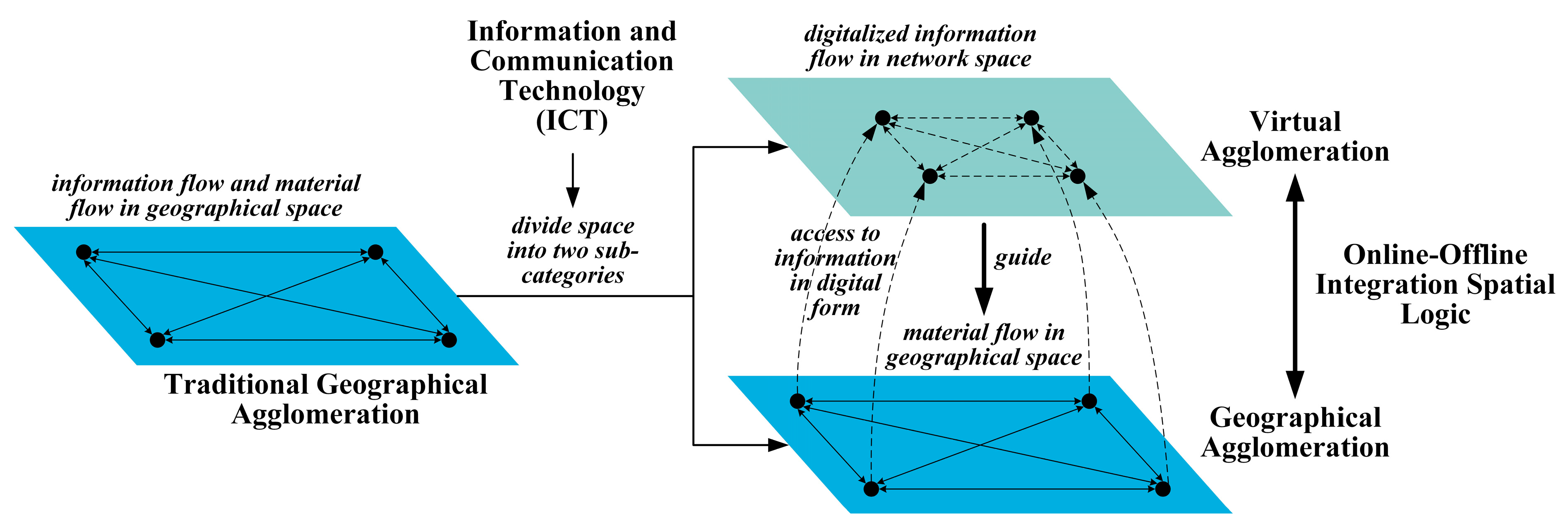
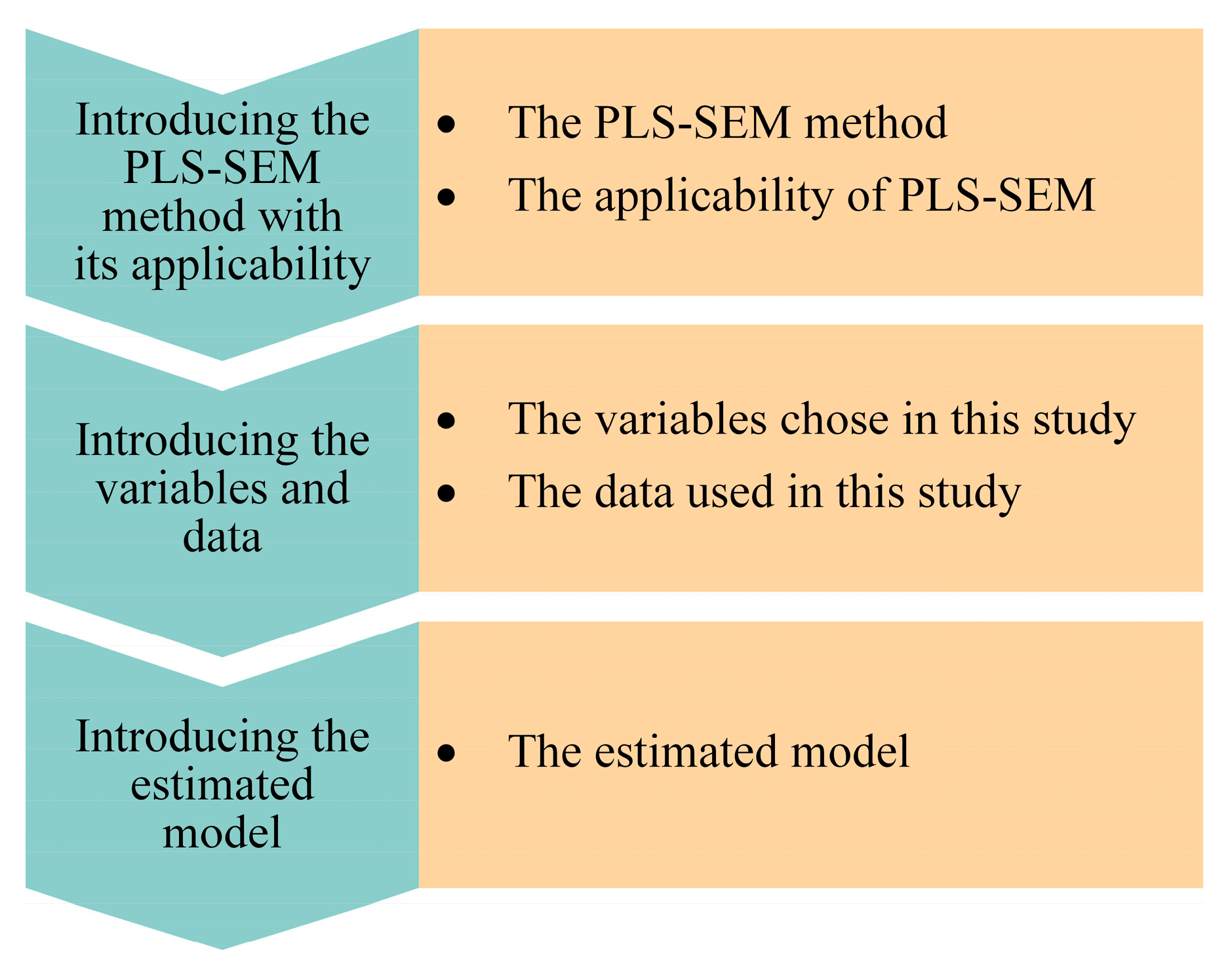

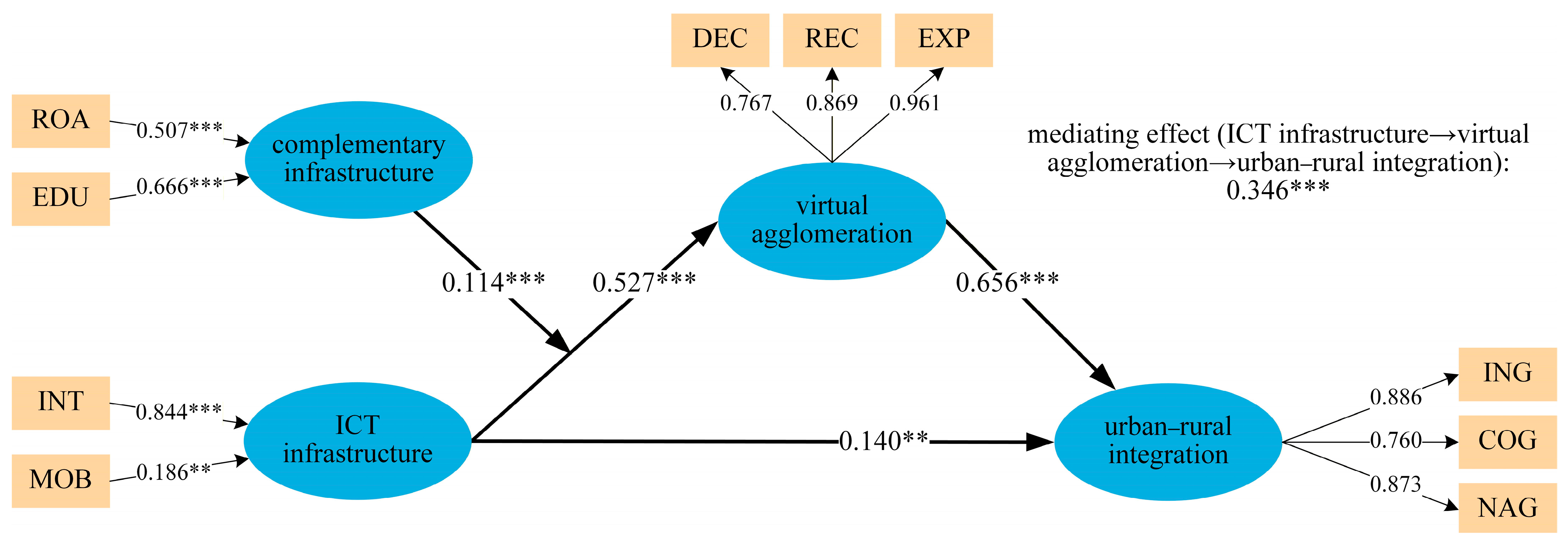
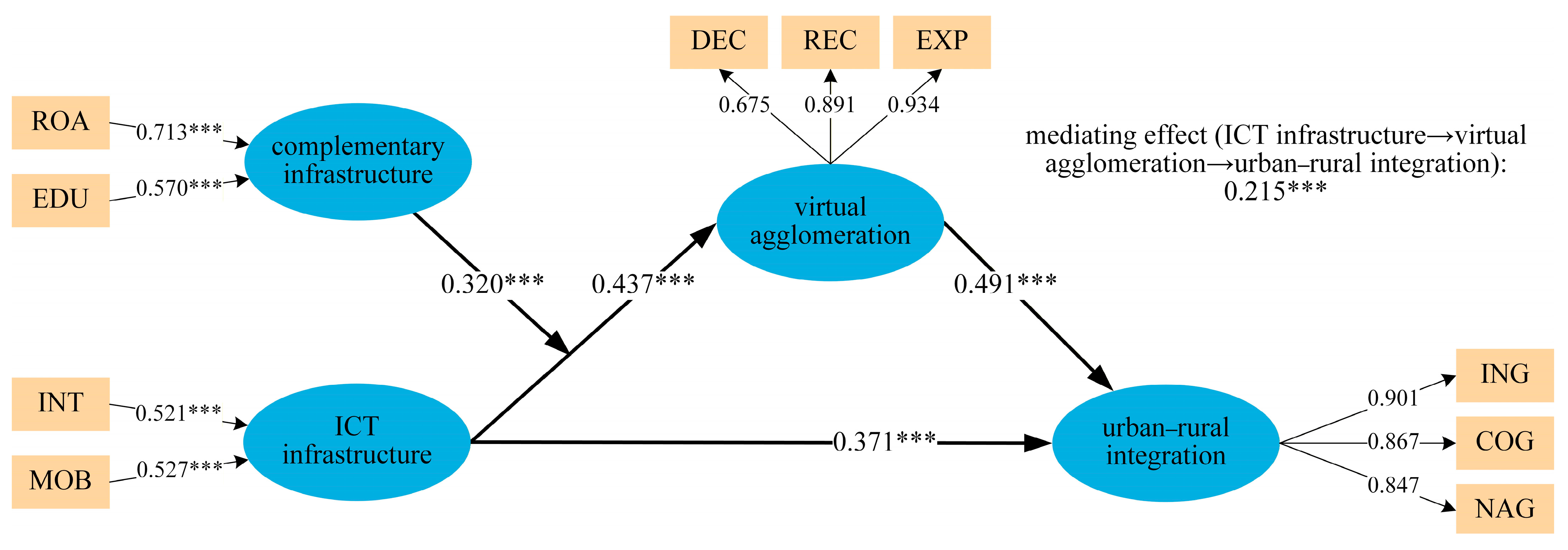
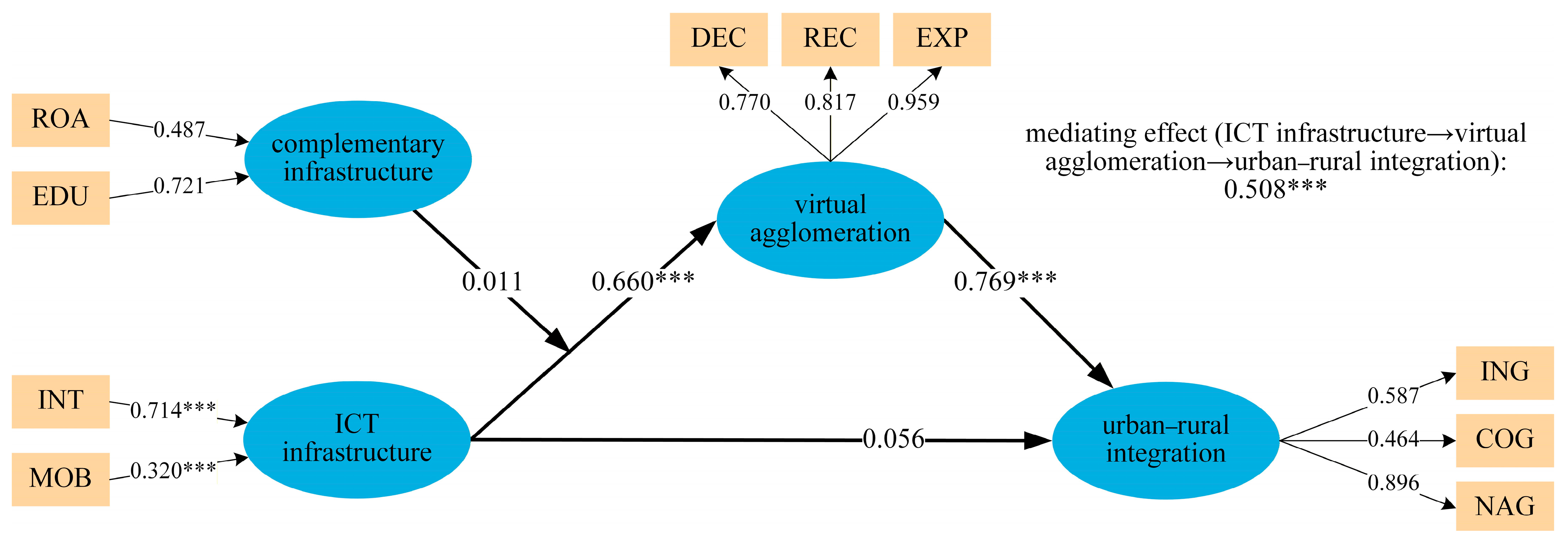
| Constructs | Measurement Variables | Obs. | Mean | S.D. | References | ||
|---|---|---|---|---|---|---|---|
| ICT infrastructure | Internet penetration | Measured by the proportion of internet subscribers in total population. | INT | 310 | 0.44 | 0.08 | Acheampong, Opoku [63] |
| Mobile phone penetration | Measured by the number of mobile phones owned per 100 people. | MOB | 310 | 4.61 | 0.22 | Haftu [54] | |
| Complementary infrastructure | Transport infrastructure: Road density | Measured by dividing the length of roads (in kilometers) by the land area (in square kilometers). | ROA | 310 | 0.62 | 0.29 | Wu, Wang [51] |
| Education infrastructure: High school education penetration | Measured by the proportion of people with high school education or higher in total population. In China, computer courses have been included in high school education since 1980s. Therefore, regions with higher high school education penetration indicate a greater proportion of people with the skills necessary to use ICT. | EDU | 310 | 0.27 | 0.07 | Yin and Choi [17] | |
| Virtual agglomeration | Development of e-commerce | Measured by the proportion of online sales in GDP. | DEC | 310 | 0.12 | 0.11 | Li, Zeng [12] |
| Development of rural e-commerce | Measured by the number of Taobao villages per 10,000 village administrative units. Taobao (www.taobao.com) is the leading e-commerce platform in China, and Taobao villages are clusters of rural e-retailers, where at least 10% of rural households engage in e-commerce or at least 100 online shops operate in the village. The data of Taobao Villages is compiled and released by the Ali Research Institute (www.aliresearch.com), which is a specialized research institute under the operator of the Taobao platform. This data has been cited not only by many governments, including the Fujian Provincial Department of Commerce (swt.fujian.gov.cn), but also by numerous studies—such as Liu and Zhou [36], Lin and Li [59], Lin [57], and Wei, Lin [28]—that use this data to explore the development status of rural e-commerce. In terms of the dualistic urban–rural structure, if a region shifts from urban-centered geographical agglomeration to virtual agglomeration, then more villages should begin to join the virtual industrial clusters. | REC | 310 | 1.88 | 2.06 | Liu and Zhou [36], Lin and Li [59], Lin [57], Wei, Lin [28] | |
| Scale of express | Measured by per capita express delivery volume (in pieces). Trades in virtual industrial clusters still rely on offline logistics; thus, the scale of express delivery can also reflect the development level of virtual agglomeration. | EXP | 310 | 2.65 | 1.21 | Yin and Choi [17] | |
| Urban–rural integration | Income gap | Measured by per capita disposable income, and is expressed as the ratio of rural to urban residents. | ING | 310 | 0.34 | 0.04 | Zeng and Chen [68], Ma, Liu [69] |
| Consumption gap | Measured by per capita consumption expenditure, and is expressed as the ratio of rural to urban residents. | COG | 310 | 0.40 | 0.05 | Zeng and Chen [68], Ma, Liu [69] | |
| The proportion of non-agricultural employed population | Measured by the proportion of workers employed in the secondary and tertiary sectors relative to the total employed population. | NAG | 310 | 0.53 | 0.08 | Zhang [25] | |
| Constructs | Measurement Variables | Mean | |
|---|---|---|---|
| Western Regions | Eastern Regions | ||
| ICT infrastructure | INT | 0.40 | 0.46 |
| MOB | 4.56 | 4.64 | |
| Complementary infrastructure | ROA | 0.42 | 0.76 |
| EDU | 0.23 | 0.29 | |
| Virtual agglomeration | DEC | 0.09 | 0.15 |
| REC | 0.67 | 2.65 | |
| EXP | 1.88 | 3.14 | |
| Urban–rural integration | ING | 0.30 | 0.36 |
| COG | 0.38 | 0.41 | |
| NAG | 0.47 | 0.57 | |
| Check List | Criteria | |
|---|---|---|
| formative measurement model | variable VIF: ensure that there are no multicollinearity issues | less than 3 |
| variable statistical significance | the confidence interval does not include zero | |
| reflective measurement model | variable loading | greater than 0.708 |
| Cronbach’s alpha, rho_A, and CR: ensure internal consistency reliability | greater than 0.7 | |
| AVE: ensure convergent validity | greater than 0.5 | |
| structural model | path VIF: ensure that there are no multicollinearity issues | less than 3 |
| path statistical significance | the confidence interval does not include zero | |
| R2: ensure the predictive power of the model | greater than 0.35 | |
| DEC | REC | EXP | ING | COG | NAG | |
|---|---|---|---|---|---|---|
| INT | 0.595 *** | 0.636 *** | 0.808 *** | 0.469 *** | 0.455 *** | 0.707 *** |
| MOB | 0.660 *** | 0.532 *** | 0.720 *** | 0.293 *** | 0.258 *** | 0.645 *** |
| ROA | 0.508 *** | 0.492 *** | 0.616 *** | 0.424 *** | 0.339 *** | 0.586 *** |
| EDU | 0.744 *** | 0.380 *** | 0.644 *** | 0.460 *** | 0.310 *** | 0.665 *** |
| Constructs | Measurement Variables | Weights | VIF | Significance | Confidence Intervals |
|---|---|---|---|---|---|
| ICT infrastructure | INT | 0.844 | 2.843 | *** | 0.696~0.979 |
| MOB | 0.186 | 2.843 | ** | 0.026~0.350 | |
| Complementary infrastructure | ROA | 0.507 | 1.243 | *** | 0.428~0.593 |
| EDU | 0.666 | 1.243 | *** | 0.585~0.734 |
| Constructs | Measurement Variables | Loadings | Cronbach’s Alpha | rho_A | CR | AVE |
|---|---|---|---|---|---|---|
| Virtual agglomeration | DEC | 0.767 | 0.834 | 0.869 | 0.902 | 0.756 |
| REC | 0.869 | |||||
| EXP | 0.961 | |||||
| Urban–rural integration | ING | 0.886 | 0.801 | 0.864 | 0.879 | 0.708 |
| COG | 0.760 | |||||
| NAG | 0.873 |
| Hypotheses and Paths | Path Coefficients | VIF | Significance | Confidence Intervals | |
|---|---|---|---|---|---|
| H1 | ICT infrastructure→Urban–rural integration | 0.140 | 2.683 | ** | 0.010~0.264 |
| H2 | ICT infrastructure→Virtual agglomeration | 0.527 | 1.549 | *** | 0.476~0.579 |
| Virtual agglomeration→Urban–rural integration | 0.656 | 2.683 | *** | 0.543~0.770 | |
| mediating effect ICT infrastructure→Virtual agglomeration→Urban–rural integration | 0.346 | / | *** | 0.284~0.412 | |
| H3 | moderating effect Complementary infrastructure→(ICT infrastructure→Virtual agglomeration) | 0.114 | 1.135 | *** | 0.062~0.161 |
| Hypotheses and Paths | Baseline Results (2013–2022) | Pre-COVID-19 Period Results (2013–2020) | Post-COVID-19 Period Results (2020–2022) | |
|---|---|---|---|---|
| H1 | ICT infrastructure→Urban–rural integration | 0.140 ** | 0.179 * | −0.069 |
| H2 | ICT infrastructure→Virtual agglomeration | 0.527 *** | 0.546 *** | 0.345 *** |
| Virtual agglomeration→Urban–rural integration | 0.656 *** | 0.591 *** | 0.871 *** | |
| mediating effect ICT infrastructure→Virtual agglomeration→Urban–rural integration | 0.346 *** | 0.323 *** | 0.300 *** | |
| H3 | moderating effect Complementary infrastructure→(ICT infrastructure→Virtual agglomeration) | 0.114 *** | 0.101 *** | −0.012 |
Disclaimer/Publisher’s Note: The statements, opinions and data contained in all publications are solely those of the individual author(s) and contributor(s) and not of MDPI and/or the editor(s). MDPI and/or the editor(s) disclaim responsibility for any injury to people or property resulting from any ideas, methods, instructions or products referred to in the content. |
© 2025 by the authors. Licensee MDPI, Basel, Switzerland. This article is an open access article distributed under the terms and conditions of the Creative Commons Attribution (CC BY) license (https://creativecommons.org/licenses/by/4.0/).
Share and Cite
Zhang, L.; Yuan, J.; Zhu, B.; Liu, B.; Ai, Q. The Mediating Role of Virtual Agglomeration in How ICT Infrastructure Drives Urban–Rural Integration: Evidence from China. Land 2025, 14, 2032. https://doi.org/10.3390/land14102032
Zhang L, Yuan J, Zhu B, Liu B, Ai Q. The Mediating Role of Virtual Agglomeration in How ICT Infrastructure Drives Urban–Rural Integration: Evidence from China. Land. 2025; 14(10):2032. https://doi.org/10.3390/land14102032
Chicago/Turabian StyleZhang, Lei, Jingfeng Yuan, Bing Zhu, Bingsheng Liu, and Qiqi Ai. 2025. "The Mediating Role of Virtual Agglomeration in How ICT Infrastructure Drives Urban–Rural Integration: Evidence from China" Land 14, no. 10: 2032. https://doi.org/10.3390/land14102032
APA StyleZhang, L., Yuan, J., Zhu, B., Liu, B., & Ai, Q. (2025). The Mediating Role of Virtual Agglomeration in How ICT Infrastructure Drives Urban–Rural Integration: Evidence from China. Land, 14(10), 2032. https://doi.org/10.3390/land14102032







